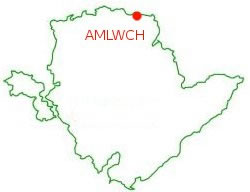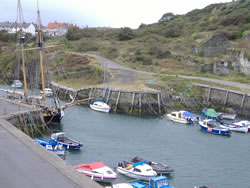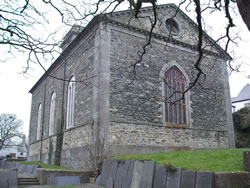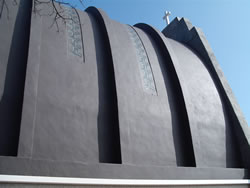Amlwch

The name Amlwch derives from two welsh words, am and llwch, meaning around or near the creek or inlet, a reference to the harbour at Porth Amlwch, which is a short walk from the town of Amlwch itself.
This town is in the north east of the island, and is the most northerly town in Wales.
It may be difficult to appreciate now, but Amlwch was once the world's leading exporter of copper. That was back in the early nineteenth century when copper, extracted from the nearby Parys Mountain, was taken to the harbour at Porth Amlwch, and loaded on to boats for export. The incoming cargo was often tobacco leaf, which was processed in one of a number of tobacco factories in Amlwch.
Another key industry was ship building, originally in timber but latterly in iron. Looking at the modest scale of the harbour, it is difficult now to imagine Amlwch was once a thriving industrial area, with ship-building yards, and a tobacco industry. Its maritime role continues to this day, and it is not unknown to see Mersey Docks and Harbour Board pilot boats moored in the outer harbour.
Amlwch was once the northern terminus of the Anglesey Central Railway, which linked to the main Holyhead to London line at Gaerwen. It closed to passenger traffic in 1964 when it fell victim to Dr Beeching's cuts, although it continued to be used for some freight traffic. The line finally closed in 1993. There are tentative plans for the restoration of at least part of Anglesey Central Railway.
You may explore Amlwch's history at the Heritage Centre and Cafe, housed in the Sail Loft. The Centre is generally open from Easter through summer.
Amlwch Chapels and Churches
In the centre of the town is St Eleth's Church, which was built in 1880 in the Neo-classical style with funds from the Parys Mountain Company. It is a Grade 2* listed building, which means it is a building of special architectural or historical interest. The clock strikes by day but is silent by night, and is wound once a week by the local butcher.
On the road to Bull Bay lies the church of Our Lady, Star of the Sea, and St. Winefride. This modernistic Roman Catholic church was designed by an Italian architect living in Conway. Completed in 1937, and extensively refurbished in 2011, the unusual design represents an upturned boat, with the round windows at ground level symbolising portholes. The church is orientated on a north-south line, which means sunlight filters through the uncoloured glass windows throughout the day. The altar was commissioned as part of the 2011 refurbishment, and is made from local Welsh slate and granite.








